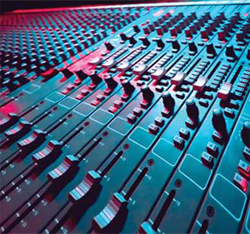
We can help our artists shine in a way that’s far removed from the limited experience the average fan might have by listening at home to their hi-fi, or on the go with their MP3 player. When a big PA says “KICK DRUM” with the authority of it’s 170,000 watts, it does it a lot differently than within the confines of a studio recording.
And that’s where the Producer Mix comes in. If you can use the sound system, play with the sound system, exploit the sound system, then you can (potentially) produce results “bigger than life” – and that’s exactly what many are seeking from their concert-going experience.
By working closely with the tonality of each instrument, by accentuating the dynamics of the act, by riding the mix so that solos stand out while backing instruments sit in the mix where they should to support the lead lines, we can paint a sonic masterpiece! Of course, we might instead paint a caricature by over-exaggerating level changes and effects sends – so let’s not go there. Needless to say, baby steps…
I’m a big fan of not setting all vocal mics at the same level as the effects—and leaving them there. When a song is sung, the vocal levels should be adjusted in relation to the accompanying music. Backing vocals must fit where they fit, and that varies widely from style to style, and even song to song.
And when the current tune is over and the front-person starts talking to the audience, it’s not so classy (is it?) to keep the level at a screeching +3 dB or +6 dB over the music (which is now silent), so they can say “Hello Philadelphia!” or whatever – drowned in reverb. This is where the idea of a Producer’s Mix comes in again, at the most basic level. All it takes is an attentive house engineer to make the appropriate changes to the level and effects send, so that the speech sounds like one person talking to another.
Mixing in this manner takes 100 percent concentration, 100 percent of the time, and does not lend itself very well to mixing in layers on small digital consoles. Layers make it difficult to grab the specific control that you need, in the quarter-note interval that it takes to make a level adjustment, or change a reverb send, without it becoming obvious that the response was late. (In my world, this is where analog wins the day.)
Getting Better All The Time
Today’s loudspeaker systems are remarkably superior to those of yesteryear. The sonic quality of each of the systems we encountered (which included numerous brands) was very good. Power, headroom, evenness of coverage, flat response – all of these desirable properties have been achieved by most of the well-known loudspeaker manufacturers.
I used CONEQ Acoustic Power Equalization for each of the shows, and that helped to normalize the sonic properties of one system to another. By running CONEQ, I was able to view and store each system’s acoustic power frequency response. The response characteristics among leading systems are surprisingly similar; this is a good sign that our industry has matured a lot in the past 20 years.
The two largest system variances that I observed (after frequency response flattening) were MF/HF distortion and definition in the subwoofers. Although almost all modern systems exhibit less distortion than earlier designs, opportunities still remain to reduce distortion in high-output driver systems.
As for subs, they all kick ass and they all sound good! The differences strike me as being about definition (i.e., transient response), rather than distortion or flat frequency response. That said, I’ll freely admit that physical placement, and how the subs are crossed over to the upper sections of the system, easily plays as great role as any other factor. And suffice to say that subs are fun!
My overall final impression from this recent mini-tour is a good one. All of the various systems were packaged very professionally. Power distro was as pro as it gets. Accessories were readily available. Cases were clean and clearly labeled.
Kudos to all of the rental companies who take pride in their work! I hope to work with you again.
Over the course of more than four decades, Ken DeLoria has tuned hundreds of sound systems, and as the founder of Apogee Sound, he developed the TEC Award-winning AE-9 loudspeaker.
